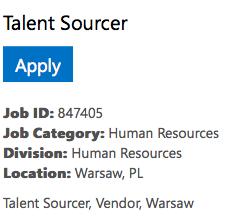 It has been a year since we checked in with Microsoft, and talked about its work in improving its mobile phone application so that applicants would have an easier time applying.
It has been a year since we checked in with Microsoft, and talked about its work in improving its mobile phone application so that applicants would have an easier time applying.
“It really was a mechanism for showcasing content,” says Microsoft’s Heather Tinguely, “but for all practical purposes it stopped short of apply.”
In other words, unless you wanted to start researching carpal-tunnel doctors, you needed to go to your desktop to finish up your application.
No longer.
Around the time I wrote that post mentioned above, the Microsoft team kicked into high gear its effort to build a better way of applying with a smartphone. Last fall and this spring, a wide variety of Microsoft teams, and external folks, worked on it. There were, among others, recruiting operations professionals; staffing marketers; developers; and the firm Punchkick Interactive, which was focusing on design.
The goal, and what took up a lot of the time, was to have the new “apply” process work seamlessly with the company’s applicant tracking system, from SAP. “We wanted everything to be a fully integrated experience,” Tinguely says.
A company that’s moving from a little-known to a major player in recruiting technology was also brought on to work on the “apply” process: Jibe.
About a month ago, a new Microsoft site launched. Candidates go to the site and “authenticate” using a variety of social media accounts. Authenticate means what you think it does. It’s a way of signing in and Microsoft figuring out that you are who you say you are.
A little thing — actually, I think it’s a big thing — is that if you sign in through Facebook, you get this notice:
Don’t worry! We won’t tell any of your friends or followers that you were here.
I’ve seen that elsewhere, but rarely so clearly stated.
Anyhow, from there, a candidate can apply for a Microsoft job using a LinkedIn profile, by emailing a resume, or through a “cloud” website like Dropbox. Or, they can use a resume already on file with Microsoft, if they have one.
If you apply using LinkedIn, you just apply. That’s it. In other words, you don’t monkey around with your LinkedIn profile to your liking. People have very small amounts of time and very small phones, Tinguely says, so editing profiles could be a hassle. “The hardest thing is making really hard decisions about user experience. How complex do we want to make it? We want to make it simple.”
I asked Tinguely why I can only share a job via email with the new mobile site, rather than sharing it on social media sites, something every startup and their brother has been launching companies for. Regarding sharing jobs on social media, she says, “There’s more hype than reality.” If you want a job, she says you want it for yourself, not someone else. “We just did not see the best performance out of that,” she says, about social job sharing. Microsoft may indeed resurrect such a feature, but it wasn’t priority one.
 Microsoft is getting about 160-175,000 visits monthly to its mobile careers site. Data on the new “apply” process list is limited, since it’s early. But in the first month about 10,000 people started applying and about half of those finished. That doesn’t include tablet users, who right now are counted as desktop users. In about a month, tablets will redirect to mobile, which will sharply increase the mobile numbers. Tinguely expects about 50,000 applications over 12 months on mobile.
Microsoft is getting about 160-175,000 visits monthly to its mobile careers site. Data on the new “apply” process list is limited, since it’s early. But in the first month about 10,000 people started applying and about half of those finished. That doesn’t include tablet users, who right now are counted as desktop users. In about a month, tablets will redirect to mobile, which will sharply increase the mobile numbers. Tinguely expects about 50,000 applications over 12 months on mobile.
There is that debate, one that went on in Redmond, about the whole optimized site vs. separate mobile application thing. Tinguely, for one, isn’t a big proponent of a separate app. “Candidates don’t hit hundreds of job boards anymore,” she says. “Instead they’re going to job aggregators. It’s the same way with apps in our space. A hundred different employer apps on their phone? They prefer optimized sites.”
The smartphone site that the Microsoft team has built is not the end of its mobile plans. Microsoft wants to build something (leaning toward cool and exciting, not just simple and streamlined) for candidates at hiring events, or for interviewees, and new hires.
Tinguely says that “our industry sometimes gets stuck … I hope we as an industry start talking about things that go beyond foundational layers.” What she’s saying is that debates over such things as having a mobile-optimized site or a separate application can waste time. Soon, everyone should and will have a mobile careers site, and the real challenge will ultimately be about branding, messaging, a value proposition, whether the job is a good one, and so on. “Candidate experience is a differentiator,” she says.